Military history of Georgia
| History of Georgia |
|---|
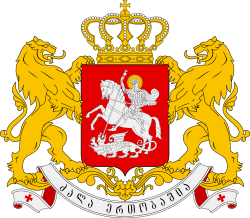 |
|
History by topic |
|
|
.jpg)
The country of Georgia has known a rich military history, both as a battlefield of empires and as an independent political and military power. The strategic significance and natural wealth of its territory made it the target of many invasions, and the country's independence was preserved against multiple enemies by a succession of states. Before the unification of the country by the Bagrationi dynasty in the 10th century, several states, such as Iberia and Colchis had managed to subsist between the Roman empire (later Byzantine Empire in the West) and the Sassanid Empire (later replaced by the Umayyad and Abbasid Caliphates). Between the 11th and 15th centuries, the Kingdom of Georgia was a major regional power, which withstood invasions by the Great Seljuk Empire, Mongol Empire, and Timurid Empire, before its fragmentation and submission to the Ottoman and Safavid Empires. Many Georgians fought in the armies of the empires that ruled the country from the 16th century, be it the Safavids (and successive Afsharids and Qajars), the Russian Empire or the Soviet Union, and the nation kept a reputation for military valour and skill. Since 1991, the newly independent Georgia has taken part in many conflicts: its conflicts with Russia culminated in the 2008 South Ossetia war, while its alliance with the United States led to Georgia's participation in the Afghan and Iraq wars.
Antiquity
Kingdom of Iberia
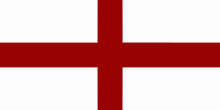
Iberia (Georgian — იბერია, Latin: Iberia and Greek: Ἰβηρία), also known as Iveria (Georgian: ივერია), was a name given by the ancient Greeks and Romans to the ancient Georgian kingdom of Kartli[1] (4th century BC – 5th century AD), corresponding roughly to the eastern and southern parts of the present day Georgia.[2][3] The term Caucasian Iberia (or Eastern Iberia) is used to distinguish it from the Iberian Peninsula, where the present day countries of Spain, Portugal and Andorra are located.
The Caucasian Iberians provided a basis for later Georgian statehood and along with Colchis (early western Georgian state) formed a core of the present day Georgian people (or Kartvelians).[4][5]
Pompey's Georgian campaign
.jpg)
Pompey invades Georgia in 65 BC after making the Kingdom of Armenia a vassal of Rome. He demands vassalage from the Iberians, but the Iberians refuse and begin partisan wars against Pompey. Roman troops are constantly ambushed in arboreous areas. Reportedly, a sizable number of women also participate in this irregular warfare. Later in the same year, the Iberians fight a battle against Pompeys main force over the Aragvi river near Mtskheta, the capital of Iberia. Greek historian Plutarch refers to that engagement as a great battle and notes that Iberian casualties consisted of approximately 9,000 while more than 10,000 were captured by the Romans. After subdueing Iberia, Pompey turns towards the Kingdom of Colchis and subjugates its various fortresses and local peoples on the way with both cunning diplomacy and the use of force.
Kingdom of Colchis
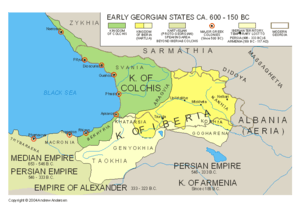
In ancient Geography, Colchis or Kolkhis (Georgian and Laz: კოლხეთი, ḳolkheti or "ḳolkha"; Ancient Greek: Κολχίς, Kolkhís) is an ancient Georgian[6][7][8][9] state[10][11] kingdom and region[12] in Western Georgia, which plays an important role in the ethnic and cultural formation of the Georgian nation.[9][13][14] Its geography is mostly assigned to what is now the western part of Georgia and encompasses the present-day Georgian provinces of Samegrelo, Imereti, Guria, Adjara, Abkhazeti, Svaneti, Racha; the modern Turkey’s Rize, Trabzon and Artvin provinces (Lazistan, Tao-Klarjeti); and the modern Russia’s Sochi and Tuapse districts.[15] The Colchians are probably established on the Black Sea coast by the Middle Bronze Age.[16]
War between Iberia and Armenia
The War between Armenia and Iberia (AD 51) is known chiefly through its description in Tacitus' Annals.[17] Fearing usurpation by Rhadamistus, his father convinces him to declare war upon his uncle and claim the Armenian throne for himself. The Iberians invade with a large army and force Mithridates to retreat into the fortress of Gorneas (Garni), which is garrisoned by the Romans under the command of Caelius Pollio, a prefect, and Casperius, a centurion. Rhadamistus is unable to take the fortress by assault or by siege. Pollio, swayed by bribery from Rhadamistus, induces the Roman soldiers to threaten the capitulation of the garrison. Under this threat, Mithridates leaves the fortress in order to make peace with Rhadamistus. Rhadamistus then executes Mithridates and his sons, despite a promise of non-violence, and becomes King of Armenia. Of this usurpation, Tacitus writes "Rhadamistus might retain his ill-gotten gains, as long as he was hated and infamous; for this was more to Rome's interest than for him to have succeeded with glory". Shortly after the Iberians are expelled from Armenia by a rebellion of the Armenian nobility which is supported by the Parthian Empire. Both kingdoms would then take sides respectively during the Roman–Parthian War of 58–63.
Late Antiquty
Iberian-Sasanian Wars

In 327 Georgia adopts Christianity and becomes a Christian state, which causes it to grow more distant from its Zoroastrian neighbor.[18][19][20] From 483 to 522 the then Georgian king Vakhtang I turns Georgia into a strong regional power. Persians refer to him as "Gorgasal", which roughly translated means wolf, due to his accordingly shaped helmet that was partially made of a wolf's head. The king wore that particular piece of armour in battle. Military ambitions also grow in that period which is reflected by a large fighting force. However refusing Persian supremecy over the region and allying with the Byzantine Empire the Iberians face numerous hostile Sasanian incursions that culminate in the defeat of the Iberians and their Armenian allies leaving the kingdom ravaged. King Vakhtang dies during an invasion when an arrow strikes through a gap of his armor.
Iberian War
The Iberian War is a conflict between the Eastern Roman and Sassanid Empires over the Georgian kingdom of Iberia,which lasts from 526 to 532. It begins following a rise of tension between the two empires in the upper Mesopotamian and Transcaucasian regions, and an anti-Persian revolt in Iberia. The war ends with the signing of the Treaty of Eternal Peace, in which the Sassanids gain possession of Iberia, and the Byzantines the region of Lazica. The treaty is then practically broken with the start of the Lazic War nine years later.
Lazic War
In the Eternal Peace treaty signed between the Sassanid and Byzantine empires, the Sassanids consider Lazica a region within the sphere of influence of Byzantine and the Lazic king at the time (Tzath I) is granted baptism from Emperor Justinian I in Constantinople. Lazica effectively becomes a protectorate of the Byzantine Empire, which eventually leads to a full scale uprising in 541, supported by the Persian Shah Khosrau I. The revolt results in the Byzantine Empire losing control over the region.
However, this changes in 548 when the situation turns against the Persians as the Lazic people begin to revolt against a Persian rule but this time around with Byzantine support.
The conflict ultimately ends with a status quo agreement made in 562, in which the Sassanids yet again recognize Lazica as a vassal state of the Byzantine Empire.
Early middle ages
War with the Umayyad Caliphate
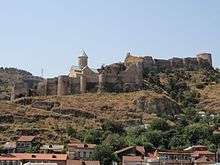
A war with the Umayyad Caliphate takes place from 735 to 737. The Georgians lose the war and the caliphate massacres a large portion of the Georgian population.
Middle Ages
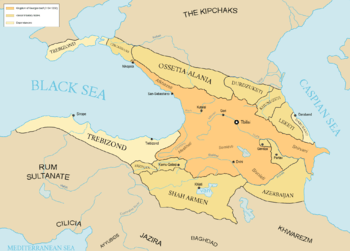

Kingdom of Georgia
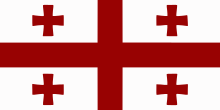
Georgia’s power reaches its peak in the years from 1180–1236, creating one of the strongest medieval kingdoms in west Asia, with the population of approximately 5 million people including peoples from vassals states and fielding a varying sizable army of 40,000 to some 90,000 troops at a time.
Byzantine–Georgian Wars
Territorial ambitions of the Byzantine Empire and the Kingdom of Georgia clash multiple times in the years 1014–1208 AD. The Byzantine Empire invades the Kingdom of Georgia losing the first major battle but ultimately recover and force the Georgian king to surrender lands after several more costly battles. Around that time the Georgians are also stuck in fighting off Seljuks and Arab invasions. The Byzantines gain a number of dominions but as soon as the Georgians regains power and resources under Queen Tamar they reconquer all territories including Tao-Klarjeti and invade Byzantium proper in order to help the Komnenos establish the Trebizond Empire.
Georgian–Seljuk wars
Battle of Didgori
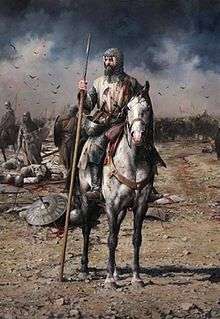
The Battle of Didgori is fought between the armies of the Kingdom of Georgia numbering around 55,000 troops and the Seljuk Empire with around 300,000 troops from a greater coalition at the fields of Didgori, 40 km west of Tbilisi, (the modern-day capital of Georgia), on 12 August 1121. The battle results in King David IV of Georgia’s decisive victory over the invading force under Ilghazi and the subsequent reconquest of a Muslim-held Tbilisi, which becomes the royal capital. The victory at Didgori inaugurates medieval Georgia’s "Golden Age" and is celebrated in the Georgian chronicles as a "miraculous victory", while modern Georgians continue to remember the event as an annual September festival known as Didgoroba ("[the day] of Didgori").[21]
Battle of Shamkor
On 1 June 1195 a 35,000 men strong Georgian army commanded by David Soslan, spouse of Tamar decicively beats an army of 70,000 men led by Atabeg Abu Bakr. The battle takes place at the modern-day Shamkir District in Azerbaijan. Abu Bakr was eventually captured as prisoner after his retreat to Nakhichevan.
Battle of Basian
On 27 July 1202 the Georgian kingdom crushes a significantly superior Muslim coalition army of the Sultanate of Rum in the Basiani Vale, located 60 km northeast from Erzurum.
Georgian weapons
King David "the Builder" made his own sword, naming it "Khmali" (literally meaning "Sword" in Georgian) and supplied his army with it. The Georgians called it "Davitiuri" which means "Sword of David" in English. David personally called it "Sword of the Messiah".
The Georgian "Davitiuri" sword was a mixture between the European Knightly sword and the Persian bow sword. Later on, this sword saw the Georgians into the Golden age of Georgia in 11-12th centuries. The Georgian "Davitiuri" sword was adopted by all Caucasian nations and became a Caucasian sword.
Mongol invasions of Georgia and Armenia
The first appearance of the Mongols in the Caucasus happens in 1220, when the Mongol generals Subutai and Jebe persuade the Khwarazmian Shah (Muhammad the IInd) to invade Georgia, caputring several of its regions and crushing a Georgian-Armenian army rushed to intercept them. Subutai and Jebe later advance northwards into Kievan Rus'. The Mongols then launch a full-scale invasion of Georgia in 1236, along with the Empire of Trebizond and the Sultanate of Rum. They take the southernmost regions of the Georgian kingdom in Armenia, effectively annexing the state, while the Armenian Kingdom of Cilicia and certain Crusader states willingly give into vassalage. Georgia enjoys a short period of independence from the Mongols under king George V, though the Timurid invasions eventually lead to its destruction.
Timur's invasions of Georgia
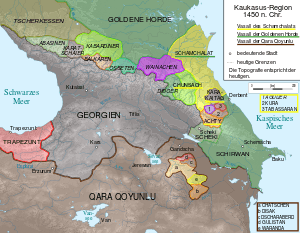
Georgia, effectively the only remaining Christian state in the Caucasus, is subjected, between 1386 and 1404, to several disastrous invasions by the armies of Turco-Mongol conqueror Timur, whose vast empire stretches, at its greatest extent, from Central Asia into Anatolia.
In the first of at least seven invasions, Timur sacks Georgia's capital, Tbilisi, and captures the king Bagrat V in 1386. Georgian resistance prompts a renewed attack by the Turco-Mongol armies. Bagrat’s son and successor, George VII, puts up stiff resistance and has to spend much of his reign (1395-1405) fighting the Timurid invasions. Timur personally leads most of these raids to subdue the recalcitrant Georgian monarch. Although he is not able to establish a firm control over Georgia, the country suffers a blow from which it never recoveres. George VII eventually signs a peace treaty with the Timurids, though at that time his kingdom consists of little more than pillaged towns, ravaged countrysides and a shattered monarchy.
Turkoman invasions of Georgia
Following the death of Turco-Mongol ruler Timurlane, his empire begins fragmenting into smaller states. One of these states is Kara Koyunlu, which takes advantage of Georgia's still weaknened state as a result of Timurs campaigns, and launches an invasion in which they kill the Georgian king George VII. The succeeding ruler, Constantine I allies himself with Shirvanshah Ibrahim I, however, he is defeated and taken captive in the Battle of Chalagan and is then executed along with 300 other Georgians. His successor Alexander I of Georgia retakes Lori from the Turkomans, and encourages the Armenian king Beskhen II Orbelian to attack them in the modern-day Syunik Province in southern Armenia. Victorious Alexander grants Beskhen the Lori province under the terms that he becomes a vassal. Jahan Shah of Kara Koyunlu consequently launches two invasions into Georgia in 1440 and 1444 due to Alexander's unwillingness to pay tribute to the Shah, sacking Tbilisi and other areas.
The Kara Koyunlu are destroyed by the Aq Qoyunlu, whom are tribal kin to Kara Koyunlu and very similar in many ways. The Aq Qoyunlu take advantage of the fragmentation of Georgia and invade several times under prince Uzun Hasan. The Georgians eventually ally themselves with the founder of the Persian Safavid Dynasty Ismail I and defeat the Aq Qoyunlu, putting an end to their invasions.
Georgian Mamluks
Georgian Mamluks in Egypt
In the thirteenth century, Egyptians begin recruiting mainly Christians of Georgia and Circassia as slave soldiers called Mamluks. After 1235, 70 percent of Egyptian Mamluks are Circassians or Georgians in origin and the other 30% were Kipchaks.
Georgian Mamluks in Iraq
At the start of the eighteenth century, Georgian Mamluks based in Iraq assert autonomy from the Ottoman Empire and found a dynasty which rules an autonomous Iraq until 1831, when the Ottomans reimpose direct rule.
Notable Georgian-Mamluk leaders of Iraq
- Hasan Pasha (1704–1723)
- Ahmad Pasha (1723–1747) son of Hasan
- Sulayman Abu Layla Pasha (1749–1762) son of Ahmad
- Omar Pasha (1762–1776) son of Ahmad
- Sulayman Pasha the Great (1780–1802) son of Omar
- Ali Pasha (1802–1807) son of Omar
- Sulayman Pasha the Little (1807–1813) son of Sulayman Great
- Said Pasha (1813–1816) son of Sulayman Great
- Dawud Pasha (1816–1831)
Early modern period
Georgian–Ottoman wars
After the Mongol invasions and the collapse of the Kingdom of Georgia, from the 16th to the 19th century, Georgia is fighting against Persian, Ottoman, and Russian rule over the region in battles such as:
- Battle of Kiziki (1520)
- Battle of Teleti (1522)
- Battle of Garisi (1556)
- Battle of Digomi (1567)
- Battle of Partskhisi (1569)
- Battle of Nakhiduri (1600)
- Battle of Tashiskari (1609)
- Battle of Martqopi (1625)
- Battle of Marabda (1625)
- Battle of Bazaleti (1626)
- Battle of Khresili (1757)
- Battle of Aspindza (1770)
1795 Persian Invasion anf fall of Tbilisi
.jpg)
In response to the Georgian King Heracluis IIs alliance with the Russian Empire that is established in 1783 by signing the Treaty of Georgievsk and his refusal to withdraw it in favour of Persian territorial ambitions the Iranian Emperor Agha Mohammad Khan Qajar sends several ultimatums and eventually declares war on Georgia sending an army in 1795 to subdue it. Amidst negotiations too weak to stand on its own Georgia turns to the Russian Empire repeatedly requesting military aid which is turned down due to political turmoil in Europe. Heraclius personally appeals to Empress Catherine the Great to pledge him a few thousand troops but he is not listened. In August 1795 a 70,000 men strong Persian army crosser the Aras to secure vassalage of the Ganja and Erivan khanates before reaching its main destination. Khan sends Heraclius his last ultimatum which is also rejected despite latter being aware that the Russian Empire has completely abandoned Georgia at that point. Khan leading a 40,000 men strong force marches towards Tbilisi to engage a comparably insignificant Georgian army of around 5,000 troops in what is known as the Battle of Krtsanisi. From the Georgian nobility all but one refuse to aid Heraclius. Some 2,000 troops of the Georgian force consist of auxiliaries from the Kingdom of Imereti. Initially Heraclius is successful in fending off the Qajar army until traitors inform Khan that the Georgians are short of manpower and in a weak state as the Iranians are about to withdraw their entire campaign. Aware of the new situation and using an artillery and cavalry duel as diversion, the Iranians are able to outflank the heavily outnumbered Georgians. Hereclius mounts a counterattack but is unable to preveil and forced to withdraw to his last defensive position while his retreat out of the city and to the mountains is covered by the remaining artillery and the Three Hundred Aragvians. After Khans victory Tbilisi is sacked and completely destroyed with most of its population massacred in the streets and 15,000 captives taken to Persia. Only a thousand men of Heraclius army survive with the Persians losing around 13,000 troops, almost a third of their force.
Absorption by the Russian Empire
In the 19th century, taking advantige of Georgia being ravaged by the Iranians the Russian Empire starts to systematically annex single Georgian dominions until all of Georgia is absorbed into the empire.
- In 1801 Russia ultimately betrays the Treaty of Georgievsk and occupies the Georgian kingdom of Kartl-Kakheti.
- in 1810 Russia occupies the Kingdom of Imereti
- in 1828 Russia occupies the principality of Guria
- in 1856 Russia occupies the principality of Samegrelo-Zemo Svaneti
- in 1865 Russia occupies the principality of Abkhazia
20th Century
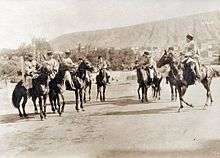
World War I
Georgia fights in the first world war as part of the Russian Empire. Out of a total population of 1.5 million around 200,000 soldiers take part in the Imperial Russian war efforts. 15,000 soldiers fight at the side of Germany in the first Georgian Legion.
Georgian-Armenian War
A brief war erupts between the two newly established Caucasus republics over the control of bordering regions ending in a military stalemate with little political and territorial gains on either side and hundreds or probably thousands of dead, wounded and captured.
The Sochi conflict
In 1918 a three-sided dispute on wheter the region of Sochi which was under Georgian-Abkhazian rule during previous centuries should be the border between Russia and Georgia, sparks a conflict over the control of the territory primarily between the Democratic Republic of Georgia, the SFSR and the White Movement. The Abkhazian nobility requests military aid from the Georgian government as Bolshevik forces are attempting to capture Sochi. Georgia responds by sending troops to repulse the Bolshevik incursion with aid of the Abkhazians resulting in the capture of all three major areas along the entire coastline as far as Tuapse while Sochi is secured. Initially the White Movement forces are considered allies by Georgia until their announcement of a Greater Russia including the entire Caucasus region as integral part. With Denikins forces pushing back the red army towards Tuapse the Georgians are forced to abandon the town but keep Sochi under their control which causes great protest among the White Movement leadership. In response Denikin conducts an unsuccessful siege of the town until the Georgian forces under general Konyev give in to increasingly overwhelming numbers and are driven back as far as the Georgian town of Gagra. Before the Georgians are able to mount a counterattack, British representatives intervene resulting in the establishment of a temporary DMZ. After failed negotiations joint Abkhaz-Georgian troops under Mazniashvili conduct a large scale offensive retaking Gagra after a bloody battle intending to move further but the operation is halted when a British contingent arrives in the capital of Georgia forcing the Georgian government to back down.
Red Army Invasion of Georgia
In 1921 Soviet Russian forces invade and ultimately annex the Democratic Republic of Georgia. Thousands of people are killed on both sides including civilians.
August Uprising
In 1924 thousands of Georgian freedom fighters (including people from Abkhazia) are killed while trying to fight the Soviet takeover and rule over their country. Over 10.000 people are executed.
World War II


With a total population of 3 million Georgia contributes with up to 700,000 soldiers to the Soviet war efforts. 300,000 soldiers die and around 400,000 return home. 30,000 Georgians fight for the Axis within the second Georgian Legion and other units including SS and Luftwaffe.
Notable Georgian figures of World War II:
Joseph Stalin, Lavrenty Beria, Konstantine Leselidze, Nikoloz Muskhelishvili, Alexander Kartveli, Alexander Nadiradze, Vladimir Janjgava, Shalva Maglakelidze, Archil Gelovani.
Notable Georgian fighters and soldiers of World War II: Dimitri Amilakhvari, Noe Adamia, Meliton Kantaria, Vasilij Kvachantiradze, Yaroslav Iosseliani.
Texel Uprising
On 5 April 1945 the 882nd Infantry Battalion of the Georgian Legion under the command of Shalva Loladze revolts against the Germans on 5 April 1945 on the island Texel in an effort to bring it under their control and surrender to the allies. However total control is not achieved and with reinforcements the Germans are able to seize the island back rounding up and killing all but a few Georgians who are sheltered and hidden by the Dutch. Over 1,300 people die in what is often described as the last battlefield in Europe.
Wars in the 1990s
War in Abkhazia
Georgia declares independence from the Soviet Union on 9 April 1991. After gaining independence, Abkhazia and South Ossetia declare independence from Georgia, which leads to a civil war in which Russia directly supports the Abkhazians. The conflict between Georgia and its separatist territories still has not yet been resolved. In 1992 Russia brokeres a cease-fire agreement between the breakaway region of South Ossetia and Georgia, during their war in the early 90's. Later in 2008 Russia declares that it recognizes South Ossetia as a sovereign nation alongside Nicaragua, Venezuela and Nauru.
21st Century
From East to West

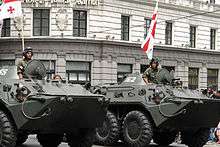
.jpg)
After the Rose Revolution, Georgia undertakes a number of efforts and initiates reforms in order to upgrade the partially very outdated military hardware and retrain its troops on Western NATO standarts and combat doctrines - wich is also to be regarded symbolic to the countries steady political shift and general advance towards the West and EU. The number of soldiers has been increased from 15,000 at the lowest point to about 37,000 at its peak while consistently increasing infrastructural quality, instituting stable insurances and raising the average salaries. As member of the Partnership for Peace initiative since 1994 and with the Georgia Train and Equip Program under the guidance and funding of the United States Georgian soldiers are able to conduct joint exercises with US troops including special forces.[22] Since 2001 Georgia acquires large quantities of mostly Soviet era armament from Ukraine, the Czech Republic, Poland etc. but also increasingly Western small arms from Israel and an amount of AR-15 type weapons from the United States that are primarily used for peacekeeping operations. However the bulk of the armed forces arsenal consists of mainly Soviet weapons to this date. The structure of the Land Forces is based on brigade and battalion-sized military units modeled to some extent after NATO structures. The Light Infantry presents the backbone of the armed forces and is being trained and retrained based on the United States Marine Corps doctrine of a quickly deployable and mobile fighting force. Georgian infantry trains and regularly participates in joint training and deployment exercises respectively with US Marines. In 1999 a special operations group is formed with financial and material assistance from Turkey. From 2001 on this mostly classified unit begins training with special forces from various partner nations including Israel. The United States also gets involved later in 2003 amidst the units first deployment to Iraq in the same year.[23]
Domestic upgrades and Industry
Georgia establishes a state weapons research unit in the early-to mid 1990s later named "Delta". Starting with the development of protection gear such as personal armor and bomb disposal suits, the institute grows and upgrades over the years partially with US funding. During WW2 Georgia was essential for the production of military equipment ranging from ammunition to aircraft and during the Cold War period missiles and parts for satellites. Short of such capabilities nowadays the current industry is still able and responsible for providing the Georgian army with the majority of equipment for personnel and to undisclosed extent even vehicles and weapons.
Part of Kosovo Force
Georgian troops become part of the NATO led Kosovo Force in 1999 and remain there until 2008 with initially 34 personnel serving under Turkish command and later in 2003 150 soldiers under German command. The contingent is withdrawn in April 2008 as Georgia is preparing to increase it's military presence in Afghanistan.
Part of the Multi-National Force – Iraq
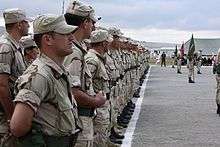
The first Georgian deployment in Iraq consists of 70 personnel medical staff, a sapper unit and special forces who are stationed in Baiji, Iraq and serve as QRF. The Georgian presence in Iraq steadily increases until it reaches its peak in 2008 at brigade strength with around 2,300 soldiers. The mission is abandoned in August 2008 due to the war with Russia and the entire contingent transferred back to Georgia. A total of five soldiers have died and 19 were wounded during their service in Iraq.
2008 War with Russia
In 2008 after a series of provocation and skirmishes from both sides the Georgian government attempts to restore constitutional order over the separatist region of South Ossetia by military force. In the fighting Russian peacekeepers get involved and some of them killed which triggers a Russian response resulting in a brief large scale conflict with hundreds of people killed, wounded and missing while tens of thousands are displaced. The Russian Federation actively supports the sessession of both breakaway regions contradicting its own firm political stance on separatism. Currently Russia is occupying 20% of Georgian de facto territory with considerable military presence.
Involvment in Afghanistan
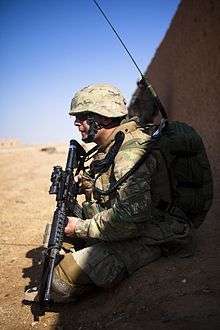
ISAF
Officially Georgia starts to deploy troops in Afghanistan in 2004. The effort is then reinforced by a medical group in 2007. Military presence is further increased by conventional troops in 2009 and entire battalions from 2010 the peak deployment being over 1,500 troops in 2012. The bulk of the peacekeeping force is consistently stationed in the volatile Helmand province. Due to the rotational deployment of almost every single infantry battalion of the armed forces, the majority of Georgian soldiers thus has participated in the ISAF efforts. Amidst completion of the operation, the Special Mountain Battalion is deployed in 2014. A total of 30 soldiers have been killed and 435 wounded during the ISAF mission.
Resolute Support
To the current Afghanistan mission Georgia contributes with 870 troops.
Central African Republic
A reinforced company of around 140 Georgian soldiers takes part in the 2014 EUFOR operation to protect Bangui, the capital of the Central African Republic and provide security for humanitarian aid convoys.[24][25]
References
- ↑ Course of Ancient Geography, Henry Immanuel Smith, p. 279.
- ↑ The Roman Eastern Frontier and the Persian Wars, Geoffrey Greatrex, Samuel N. C. Lieu, p. 82
- ↑ The Emperor Domitian, Brian W. Jones, p. 156.
- ↑ Ronald Grigor Suny. The Making of the Georgian Nation. Indiana University Press, p. 13 ISBN 0-253-20915-3.
- ↑ William Coffman McDermott, Wallace Everett Caldwell. Readings in the History of the Ancient World. p. 404.
- ↑ Ronald Grigol Suny, The Making of the Georgian Nation, p 9
- ↑ Georgia in Antiquity: A History of Colchis and Transcaucasian Iberia, 550 BC-AD 562, David Braund Oxford: Clarendon Press, 1994. Pp. 359
- ↑ The Making of the Georgian Nation, Ronald Grigor Suny, p. 13
- 1 2 Modern Hatreds: The Symbolic Politics of Ethnic War, Stuart J. Kaufman, p. 91
- ↑ Cyril Toumanoff, Studies in Christian Caucasian History, p 69
- ↑ One Europe, Many Nations: A Historical Dictionary of European National Groups, James Minahan, p. 282
- ↑ Marc Van de Mieroop, A History of the Ancient Near East, ca. 3000–323 BC, p 265 ISBN 978-1405149112
- ↑ Charles Burney and David Marshal Lang, The Peoples of the Hills: Ancient Ararat and Caucasus, p. 38
- ↑ Oliver Wardrop, The Kingdom Of Georgia: Travel In A Land Of Women, Wine And Song (Kegan Paul Library of History and Archaeology)
- ↑ Andrew Andersen, History of Ancient Caucasus, p. 91
- ↑ David Marshal Lang, the Georgians, Frederich A. Praeger Publishers, New York, p 59
- ↑ Tacitus. Annals. Book XII, Chapters 44-51. Retrieved 10 May 2012.
- ↑ Theodor Dowling, Sketches of Georgian Church History, New York, 1912, p 37
- ↑ Charles Burney and David Marshal Lang, The Peoples of the Hills: Ancient Ararat and Caucasus, p. 22
- ↑ Allen, W.E.D.: A History of the Georgian People, 1932, p. 64
- ↑ Suny, Ronald Grigor (1994), The Making of the Georgian Nation, p. 36. Indiana University Press, ISBN 0-253-20915-3
- ↑ http://gfsis.org/media/download/GSAC/resources/PFP.pdf
- ↑ http://www.globalsecurity.org/security/library/report/2004/pgt_2003/pgt_2003_31621pf.htm
- ↑ http://www.civil.ge/eng/article.php?id=27322
- ↑ http://www.eeas.europa.eu/archives/csdp/missions-and-operations/eufor-rca/news/archives/20150221_en.htm
